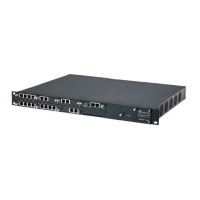Version 6.6 425 October 2014
Installation & Operation Manual 37. Using Auxiliary Files
Carrier Freq [Hz] – The Carrier signal frequency when the tone is Amplitude
Modulated.
Modulation Freq [Hz] – The Modulated signal frequency when the tone is
Amplitude Modulated (valid range from 1 Hz to 128 Hz).
Signal Level [-dBm] – The tone level when the tone is Amplitude Modulated.
AM Factor [steps of 0.02] – The amplitude modulation factor. Valid values: 1 to
50. Recommended values: 10 to 25.
Default Duration [msec] - The default duration (in 1 msec units) of the
generated tone.
Notes:
• When defining the same frequencies for both a continuous tone and a cadence
tone, the Signal On Time parameter of the continuous tone should have a
value that is greater than the Signal On Time parameter of the cadence tone.
Otherwise, the continuous tone is detected instead of the cadence tone.
• The tone frequency should differ by at least 40 Hz from one tone to other
defined tones.
37.2.1.2 The User-Defined Tones Section Format
In the "source" Call Progress Tones file, the User-Defined Tones section starts from
the following string:
[NUMBER OF USER DEFINED TONES] - contains the following key only:
Number of User Defined Tones - defines the number of User Defined Tones to
be defined in the file.
[USER DEFINED TONE #X] - contains the X
th
tone definition (starting from 0 and not
exceeding the number of User Defined Tones -1 defined in the first section) using the
following keys:
Tone Type - Call Progress ToneType
Basic Tone Type Indices (The number is the tone-type code)
1. Dial Tone
2. Ringback Tone
3. Busy Tone
4. Congestion Tone
5. N/A
6. Warning Tone
7. Reorder Tone
8. Confirmation Tone
9. Call Waiting Tone
Low Freq [Hz] – The frequency in Hertz of the lower tone component for a dual
frequency tone, or the frequency of the tone for a single tone.
High Freq [Hz] – The frequency in Hertz of the higher tone component for of a
dual frequency tone, or zero (0) for a single tone.

